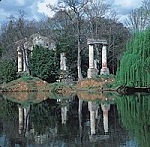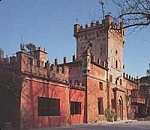| Comune: | Pistoia |
| Località: | Scornio |
| Via: | Via Dalmazia, 356 |


In the 18th century Tommaso Puccini commissioned the Pistoia engineer Buonsignori to design a villa for him. Between 1825 and 1845, Tommaso's son Niccolò Puccini had a park laid out around the villa and enhanced the natural features with artificial elements. Tommaso Puccini's idea was to add statues representing personages from the world of culture as a way of extolling national cultural and scientific progress, and awaken in the visitor a sense of aesthetic and ethical pleasure. For this purpose he placed in the park statues of Dante, of Francesco Ferrucci, of Wisdom, of Michelangelo, as well as a column topped with a statue of Linnaeus, Galileo's hemicycle and the Temple of Pythagorus. Two examples of buildings in the "Gothic Revival" style were also added, in keeping with the romantic tastes of the 19th century, namely a church and a miniature medieval castle. Again for scientific purposes, Niccolò Puccini, one of the promoters of the 'Commemorative Society of Great Italians", made the villa available to Filippo Pacini, providing him also with a microscope, thus enabling the great Pistoia-born scientist to carry out the first anatomical and histological studies. When Niccolò died, the property was divided up. The upkeep of the buildings has been neglected of late, and as a result the property now stands in a very poor state of repair. The medieval castle, one of the few well-preserved parts, is a private home; the English Gothic-style church is used as a carpenter's workshop; the other constructions, such as Galileo's Hemicycle, are used to store farming equipment. Most of the trees are of the oak family (Quercus ilex L., Quercus robur, Quercus pubescens, Quercus petrae), but there are also plane trees (along the entrance drive), silver American cypresses, Lebanon cedars, pines, lime trees, and box and laurel hedges. Perhaps the most characteristic part of the park, however, are the camellias, exotic plants that were very fashionable at the time. The villa now houses a music school and the Italian Organ Music Academy.

